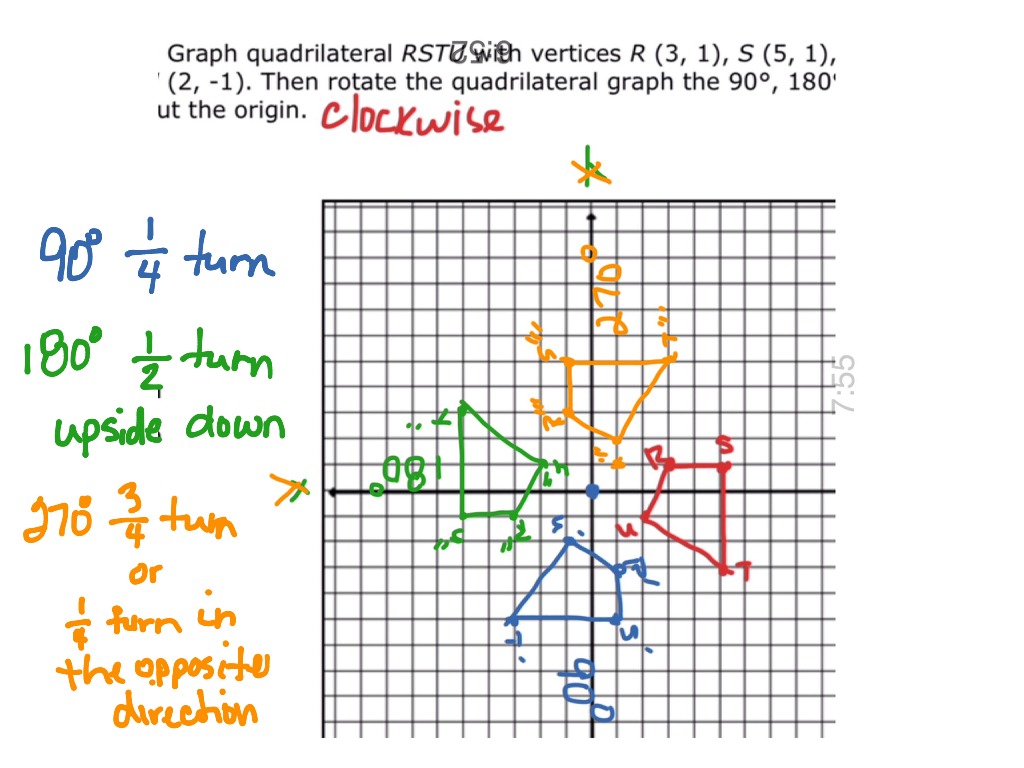

Note that the two key points, A and B, have coordinates (2, 1) and (4, 3). Rotate the given line segment about the origin by 60 degrees clockwise. This puts A’ at the point (0, 3), which is the required rotation. Call the other end of this segment A’.įinally, orient the line segment with endpoint A’ so that this segment and the original segment form a 90-degree angle counterclockwise. Next, create a second line segment of the same length, 3 units, with one endpoint at the origin. Note that the length of this segment is 3 units. Then, create a line segment connecting A to the origin. Example 1 Solutionįirst, plot the point on the coordinate plane. Rotate point A about the origin by 90 degrees counterclockwise. This section covers common examples of problems involving geometric rotations and their step-by-step solutions. Geometric Rotation DefinitionĪ geometric rotation is a transformation that rotates an object or function about a given, fixed point in the plane at a given angle in a given direction. The location of the endpoint of this new segment is the rotation of the key point that is the endpoint of the original line segment. Then, orient the copied segment to form the given angle in the given direction with the original line segment. Next, for each of these line segments, create a new segment of equal length such that one endpoint of the new segment is the point of rotation. Then, draw a line segment from each of the key points to the point of rotation.
#Rotation geometry how to#
How to Do Rotations in GeometryĪs with other transformations, begin by finding the key points’ coordinates in the given function or object. The point of rotation may be a vertex of a given object or its center in other situations. The most common point of rotation is the origin (0, 0). This measure can be given in degrees or radians, and the direction - clockwise or counterclockwise - is specified. The geometric object or function then rotates around this given point by a given angle measure. The angle of rotation will always be specified as clockwise or counterclockwise.īefore continuing, make sure to review geometric transformations and coordinate geometry.Ī rotation in geometry is a transformation that has one fixed point. The given point can be anywhere in the plane, even on the given object.

You can set the rotation by attribute option in the Map Viewer when configuring the style for your layer.Rotation in Geometry - Examples and ExplanationĪ rotation in geometry moves a given object around a given point at a given angle. You can rotate polygons and polylines using geometry tools because their vertices get updated, but not for points (the geometry is not actually changed when there is a symbol rotation).įor points, this is only a visual representation based on an attribute - therefore, this visual representation can only be changed by updating the attribute value.

This will make it easier to determine the correct angle rotation visually. Notice that the symbol is rotated dynamically as the angle value is changed without having to first save the attribute updates.
#Rotation geometry update#
Update the values for existing features for WIND_DIRECT and WIND_SPEED fields. See this sample: Editor with visual variables data (rotation & size) (codepen.io) You'll be able to use this in apps that use the Editor, such as Map Viewer, Experience Builder, and the Instant Apps.

Similar functionality is now supported in the Editor widget with Visual Variables.


 0 kommentar(er)
0 kommentar(er)
